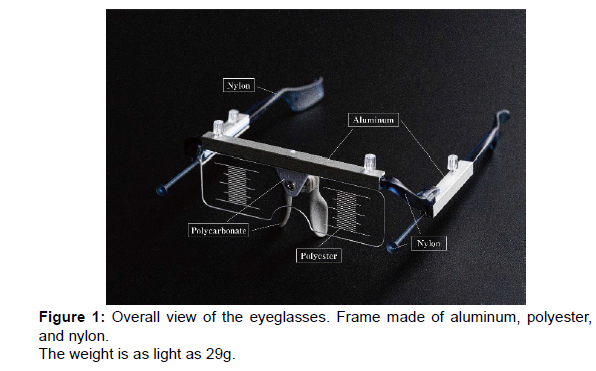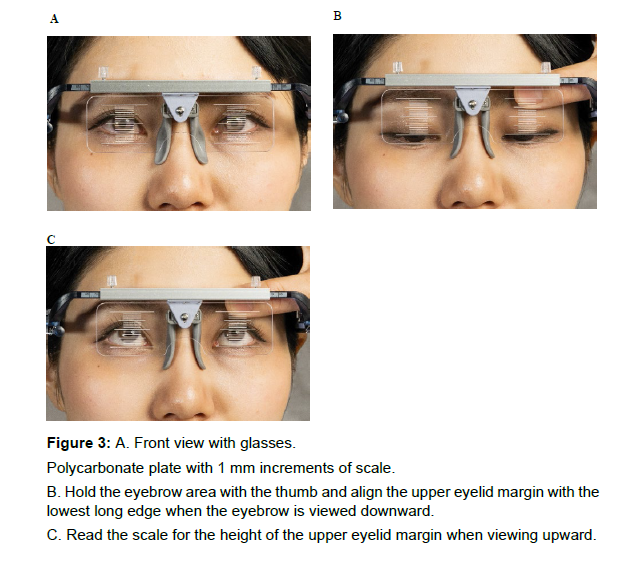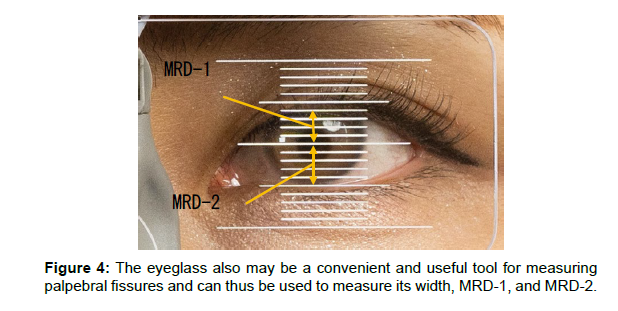Eyeglasses Development for Measuring the Upper Eyelid Levator Function
Received: 17-Feb-2023 / Manuscript No. omoa-23-89537 / Editor assigned: 20-Feb-2023 / PreQC No. omoa-23-89537 / Reviewed: 06-Mar-2023 / QC No. omoa-23-89537 / Revised: 13-Mar-2023 / Manuscript No. omoa-23-89537 / Published Date: 20-Mar-2023
Abstract
Accurate measurement of upper eyelid levator function is critical in diagnosing and treating patients with ptosis. In this article, we introduce our new eyeglasses for upper eyelid levator muscle measurement, which are simple, reproducible, and stable. The measuring eyeglasses can be adjusted to fit the face size and interpupillary distance of patients ranging from children to adults. It also maintains sufficient space to hold the upper part of the eyebrow and is extremely lightweight, weighing only 29g. The optical part of the glasses has a graduated plate that allows the position of the eyelid to be read from the front and the position of the eyelid. It also has the advantage of easily measuring palpebral fissures and can thus be used to measure its width, MRD-1, and MRD-2.
Keywords
Eyeglasses; Upper eyelid levator function; Blepharoptosis
Introduction
Accurate measurement of upper eyelid levator function is extremely important because it is the criterion for determining the surgical technique [1] and is also known to play a significant role in postoperative outcomes [2-7].
The conventional method of measuring upper eyelid levator function has been to place a ruler (scale measure) on the external eye angle, hold the upper part of the eyebrow with the finger, reduce the influence of the frontalis muscle, and read the scale on the measure for changes in eyelid margin height [8]. However, it is believed that there were some difficulties in reproducibility, as well as errors caused by the difficulty of one-handed measurement and the shifting of the reference line when measuring.
This article presents our invention of eyeglasses for measuring the upper eyelid levator muscle function. The measuring eyeglasses can be adjusted to fit the face size and interpupillary distance of patients ranging from children to adults. The overall appearance is shown in (Figure 1). The distinctive feature of these eyeglasses is the ability to change the glasses' width and the temples' length and retain enough space to hold back the upper part of the eyebrows (Figure 2). It is also made of aluminum, nylon, and polyester and weighs only 29 g. The optical part of the glasses is a graduated plate (polycarbonate), which allows the eyelid position to be read from the front and the eyelid position to be marked with a water-based pen.
Figure 2: A. The frame width and temple length are extended. The spring is internal, so it returns to its original position when released.
As it can be adjusted to the size of the face, the interpupillary distance from children to the elderly can be adjusted.
B. Sufficient space to restrain the brow area.
How to use the eyeglasses for measuring eyelid levator muscle function is as follows (Figure 3).
Figure 3: A. Front view with glasses.
Polycarbonate plate with 1 mm increments of scale.
B. Hold the eyebrow area with the thumb and align the upper eyelid margin with the lowest long edge when the eyebrow is viewed downward.
C. Read the scale for the height of the upper eyelid margin when viewing upward.
1. Put on the pair of eyeglasses, press your finger on the top of the eyebrow from inside the frame of the glasses, and look downwards. Align the upper eyelid margin of one eye with the lowest long line when the eye is made to look downward.
2. The patient is asked to look upward while holding the top of the eyebrow and the height of the upper eyelid margin is measured when looking upward.
3. Perform the steps in (1) and (2) with the other eye.
The above procedures are presented in the Supplementry video.
https://ogasawara-eye-clinic.or.jp/movie/eyeglasses.mp4
To confirm the accuracy and reproducibility of the measurement method, two certified orthoptist performed three measurements on a total of 12 normal subjects between the ages of 25 and 55 and compared them and confirmed that the results were highly reproducible and very stable.
The eyeglasses for upper eyelid levator measurement described in this article may be a convenient and useful tool for measuring the function of the eyelid levator muscles in the routine care of patients with ptosis. It also has the advantage of easily measuring palpebral fissures and can thus be used to measure its width, MRD-1, and MRD- 2. (Figure 4).
Acknowledgments
We have not received any fund for this study. We would like to express our gratitude for support to create and provide prototype of the present eyeglasses by Takashi Yamada of OBC Co., Tokyo, Japan. We also thank Mr.Hisato Nakatsubo for editing the Supplementary video.
Disclosure
The authors report no conflict of interest.
References
- Adel Alsuhainabani (2022) Blepharoptosis: EyeWiki.
- Timothy McCulley J,Robert Kersten C,Dwight Kulwin R,William Feuer J (2003) Outcome and influencing factors of external levator palpebrae superioris aponeurosis advancement for blepharoptosis. Adv Ophthalmic Plast Reconstr Surg 19:383-393.
- Luciano Pereira S,Thomas Hwang N,Robert Kersten C,Kathryn Ray,Timothy McCulley J (2008) Levator superioris muscle function in involutional blepharoptosis. Am J Ophthalmol 145:1095-1098.
- Stefano Ranno,Matteo Sacchi,Mithra Gonzalez O,Meher Ravula T,Paolo Nucci (2014) Evaluation of levator function for efficacy of minimally invasive and standard techniques for involutional ptosis. Am J Ophthalmol 157: 2019-2113.
- Hsin-Ti Lai,Shih-Feng Weng,Chih-Hau Chang,Shu-Hung Huang,Su-Shin Lee, et al. (2017) Analysis of Levator Function and Ptosis Severity in Involutional Blepharoptosis. Ann Plast Surg 78: s58-s60.
- Şimşek I,Zeynep Parlakgüneş (2018) The Importance of Levator Function in Determining the Levator Resection Surgery Results for Blepharoptosis Patients. Turk Klin J Ophthalmol 27: 45-50.
- Şimşek I,Zeynep Parlakgüneş (2018) The Importance of Levator Function in Determining the Levator Resection Surgery Results for Blepharoptosis Patients. Turk Klin J Ophthalmol 27: 45-50.
- Crowell Beard (1981) Ptosis. (3rd Edition), The C.V.Mosby Company, St Louis, Tront, London.
Indexed at, Google Scholar, Crossref
Indexed at, Google Scholar, Crossref
Indexed at, Google Scholar, Crossref
Indexed at, Google Scholar, Crossref
Citation: Ogasawara K, Risa Saito CO, Miyo Takano CO (2023) EyeglassesDevelopment for Measuring the Upper Eyelid Levator Function. Optom OpenAccess 8: 188.
Copyright: © 2023 Ogasawara K, et al. This is an open-access article distributedunder the terms of the Creative Commons Attribution License, which permitsunrestricted use, distribution, and reproduction in any medium, provided theoriginal author and source are credited.
Share This Article
Recommended Journals
Open Access Journals
Article Usage
- Total views: 1093
- [From(publication date): 0-2023 - Apr 11, 2025]
- Breakdown by view type
- HTML page views: 856
- PDF downloads: 237




